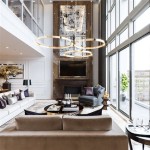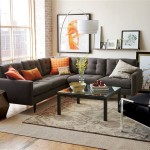Ideas for Living Room Window Treatments
The living room, often considered the heart of a home, serves as a central gathering space for families and a welcoming point for guests. Achieving the ideal ambiance within this space necessitates careful consideration of design elements, with window treatments playing a pivotal role. Effective window treatments not only enhance the aesthetic appeal but also contribute to functionality, impacting factors such as light control, privacy, and energy efficiency. This article explores a range of window treatment options for living rooms, highlighting their distinct characteristics and suitability for different design preferences and practical needs.
Understanding the Purpose of Window Treatments
Before delving into specific window treatment ideas, it is crucial to establish the intended purpose. Window treatments serve multifaceted functions. Primarily, they control the amount of natural light entering the room. This is crucial for managing glare, protecting furniture from fading, and creating a comfortable environment for various activities, from watching television to reading. Secondly, window treatments provide privacy, shielding the interior from external views. This is particularly important for living rooms located on ground floors or in densely populated areas. Thirdly, window treatments contribute to energy efficiency by insulating the room, reducing heat loss in colder months and preventing excessive heat gain in warmer months. Finally, they significantly influence the overall aesthetic of the living room, acting as a decorative element that complements the existing décor and reflects the homeowner's personal style.
The specific purpose dictates the type of window treatment that will be most effective. For example, a living room with large windows facing a busy street might prioritize privacy and glare reduction, while a living room in a more secluded location might focus on maximizing natural light and enhancing the view.
Exploring Different Types of Window Treatments
The market offers a diverse array of window treatment options, each with its unique advantages and disadvantages.
Curtains: Curtains are a classic and versatile choice, available in a wide range of fabrics, colors, patterns, and styles. They can be sheer, semi-sheer, or opaque, offering varying degrees of light control and privacy. Heavier fabrics, such as velvet or brocade, provide excellent insulation and light blocking, while lighter fabrics, such as linen or voile, allow for diffused light and a more airy feel. Curtains can be hung in various ways, including rod pocket, grommet, or pleated styles, each influencing the overall aesthetic. Consider the length of the curtains; they can be hung to just touch the floor, puddle slightly for a more luxurious look, or hang just below the windowsill for a more casual appearance.
Drapes: Drapes are similar to curtains but are typically made from heavier, more formal fabrics, often with a lining for added insulation and light blocking. They are usually pleated and hung from a decorative rod, creating a more structured and elegant look. Drapes are ideal for living rooms with a more formal or traditional design.
Blinds: Blinds consist of horizontal or vertical slats that can be tilted open or closed to control light and privacy. They are available in various materials, including wood, faux wood, aluminum, and vinyl. Venetian blinds, with their horizontal slats, are a popular choice, while vertical blinds are often used for larger windows or sliding glass doors. Blinds offer a clean and contemporary look and are relatively easy to clean and maintain.
Shades: Shades are made from a single piece of fabric that is raised or lowered to control light and privacy. They come in various styles, including roller shades, roman shades, cellular shades, and pleated shades. Roller shades are simple and streamlined, rolling up into a tube at the top of the window. Roman shades fold up into horizontal pleats when raised, creating a more architectural look. Cellular shades, also known as honeycomb shades, have a cellular construction that provides excellent insulation. Pleated shades are similar to cellular shades but have a less defined pleat.
Shutters: Shutters are a more permanent window treatment option, consisting of hinged panels that can be opened or closed to control light and privacy. They are typically made from wood or composite materials and can be painted or stained to match the décor. Shutters offer a classic and sophisticated look and provide excellent insulation and security. Plantation shutters, with their wider louvers, are a popular choice for living rooms.
Valances and Cornices: Valances and cornices are decorative window treatments that are used to top off curtains, drapes, or blinds. Valances are soft, fabric coverings that are hung across the top of the window, while cornices are rigid, box-like structures that are often made from wood or upholstered fabric. They add a touch of visual interest and can conceal hardware or imperfections above the window.
Key Considerations for Selecting Window Treatments
Choosing the right window treatments for a living room involves considering several factors beyond personal preference. Practical considerations, such as the room's orientation, the climate, and the level of privacy required, should inform the selection process.
Light Control: The amount of natural light entering the living room is a crucial factor. South-facing rooms tend to receive the most sunlight, requiring window treatments that can effectively block glare and reduce heat gain. North-facing rooms, on the other hand, receive less direct sunlight, so window treatments that allow for maximum light penetration may be preferred. Consider layered window treatments, such as sheer curtains paired with heavier drapes, to provide flexibility in light control.
Privacy: The level of privacy required will depend on the location of the living room and the proximity of neighboring buildings. For living rooms that face a busy street or have close neighbors, opaque curtains, blinds, or shutters may be necessary. Sheer curtains or shades can provide a degree of privacy while still allowing natural light to filter through. Window films offer another option for enhancing privacy without completely blocking the view.
Energy Efficiency: Window treatments can significantly impact energy efficiency by providing insulation and reducing heat loss or gain. Cellular shades are particularly effective at insulating windows, while heavier fabrics like velvet or blackout curtains can block out sunlight and prevent heat from entering the room during the summer months. Consider energy-efficient window treatment options to save on heating and cooling costs.
Style and Décor: The window treatments should complement the overall style and décor of the living room. For a traditional living room, drapes with intricate patterns or formal valances may be appropriate. For a more modern living room, simple blinds or roller shades may be a better choice. Consider the color, texture, and pattern of the window treatments and how they will coordinate with the existing furniture, wall color, and accessories.
Budget: The cost of window treatments can vary widely depending on the type of material, the size of the windows, and whether they are custom-made or ready-made. Establish a budget before beginning the selection process to avoid overspending. Ready-made curtains and blinds are generally more affordable than custom-made options. Consider purchasing window treatments during sales or using coupons to save money.
Maintenance: Consider the maintenance requirements of different window treatment options. Some window treatments, such as blinds and shutters, are relatively easy to clean, while others, such as drapes and curtains, may require professional cleaning. Choose window treatments that are easy to maintain and fit into your lifestyle.
Combining Different Window Treatments for a Layered Look
Layering window treatments involves combining different types of window coverings to create a more dynamic and functional look. This approach offers enhanced light control, privacy, and visual interest. For example, pairing sheer curtains with heavier drapes allows for diffused light during the day and complete privacy at night. Combining blinds with valances adds a decorative touch while providing adjustable light control. Consider the color, texture, and pattern of the different layers to create a cohesive and visually appealing design.
When layering, consider the functionality of each layer. The innermost layer, closest to the window, should typically be the most functional, providing privacy and light control. The outer layer should be more decorative, adding visual interest and complementing the overall décor. Experiment with different combinations to find the perfect balance of style and functionality for the living room.
The hardware used to hang window treatments also plays a crucial role in the overall aesthetic. Decorative rods, finials, and tiebacks can add a touch of elegance and sophistication to the living room. Choose hardware that complements the style of the window treatments and the overall décor. Consider the weight of the window treatments when selecting hardware to ensure that it is strong enough to support them.
Ultimately, the best window treatments for a living room are those that meet the specific needs and preferences of the homeowner, while also enhancing the overall aesthetic and functionality of the space. Careful consideration of the factors discussed in this article will help in making informed decisions and creating a living room that is both beautiful and comfortable.
:strip_icc()/DBurns-5737a7f0b3404e2eb620752ba316f5ef.jpeg?strip=all)
20 Best Living Room Window Treatment Ideas

Top 4 Living Room Window Treatment Ideas Blindsgalore Blog

The Dos And Don Ts Of Choosing Window Treatments Pella

Top 4 Living Room Window Treatment Ideas Blindsgalore Blog

Interior Design Academy Of Blog 6 Best Window Treatments Ideas

30 Beautiful Living Room Curtain Ideas And Window Treatments
:strip_icc()/01_AllisonBabcock_DanielsLane_PhotoCredit_FrancineFleisher-f5f71afc3ab54cb5ae75dcc070366c4c.jpg?strip=all)
20 Best Living Room Window Treatment Ideas

8 Modern Curtain Designs For Living Room Designcafe

29 Gorgeous Living Room Window Treatment Ideas

Stunning Living Room Window Treatments Forbes Home








